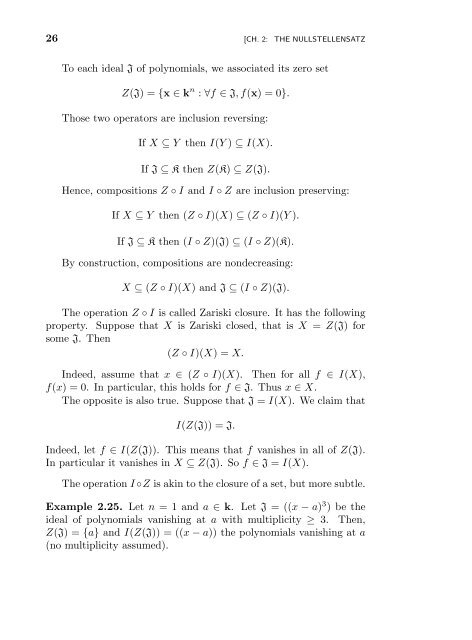Nonlinear Equations - UFRJ
Nonlinear Equations - UFRJ
Nonlinear Equations - UFRJ
You also want an ePaper? Increase the reach of your titles
YUMPU automatically turns print PDFs into web optimized ePapers that Google loves.
26 [CH. 2: THE NULLSTELLENSATZ<br />
To each ideal J of polynomials, we associated its zero set<br />
Z(J) = {x ∈ k n : ∀f ∈ J, f(x) = 0}.<br />
Those two operators are inclusion reversing:<br />
If X ⊆ Y then I(Y ) ⊆ I(X).<br />
If J ⊆ K then Z(K) ⊆ Z(J).<br />
Hence, compositions Z ◦ I and I ◦ Z are inclusion preserving:<br />
If X ⊆ Y then (Z ◦ I)(X) ⊆ (Z ◦ I)(Y ).<br />
If J ⊆ K then (I ◦ Z)(J) ⊆ (I ◦ Z)(K).<br />
By construction, compositions are nondecreasing:<br />
X ⊆ (Z ◦ I)(X) and J ⊆ (I ◦ Z)(J).<br />
The operation Z ◦ I is called Zariski closure. It has the following<br />
property. Suppose that X is Zariski closed, that is X = Z(J) for<br />
some J. Then<br />
(Z ◦ I)(X) = X.<br />
Indeed, assume that x ∈ (Z ◦ I)(X). Then for all f ∈ I(X),<br />
f(x) = 0. In particular, this holds for f ∈ J. Thus x ∈ X.<br />
The opposite is also true. Suppose that J = I(X). We claim that<br />
I(Z(J)) = J.<br />
Indeed, let f ∈ I(Z(J)). This means that f vanishes in all of Z(J).<br />
In particular it vanishes in X ⊆ Z(J). So f ∈ J = I(X).<br />
The operation I ◦Z is akin to the closure of a set, but more subtle.<br />
Example 2.25. Let n = 1 and a ∈ k. Let J = ((x − a) 3 ) be the<br />
ideal of polynomials vanishing at a with multiplicity ≥ 3. Then,<br />
Z(J) = {a} and I(Z(J)) = ((x − a)) the polynomials vanishing at a<br />
(no multiplicity assumed).

















